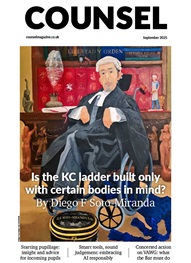*/
Edited by Chris Miele
Merrell Publishers; Hardback (April 2010); £35
ISBN: 1858945070
This book is one of the best things to come out of the transformation of the Middlesex Guildhall from a Crown Court into the Supreme Court. Lavishly illustrated with superb photographs, plans and drawings, it is also a wonderful read. There are eight essays from, amongst others, Lady Hale, Lord Bingham, and top notch art and architectural historians. Together they explain the judicial functions of the House of Lords leading to the creation of the Supreme Court, the history of the building and its predecessors on this site, the architecture of the present Guildhall together with its glorious decorative arts and sculpture inside and out, and the iconography of supreme courts in the common law world which over the decades has moved from imperial grandeur to glass box transparency.
There is also a fascinating history of Parliament Square itself through the centuries as it accidentally turned into a “traffic island laid out to display sculpture”. The present Mayor of London has shelved plans to turn this “a green glade of heroes into a vast, blasted chewing gummed piazza”.
Hugh Fielden, architect for the Supreme Court project, describes clearly how the team went about their task including their battles with the conservationists. Readers will decide whether they agree that “the cultural significance of the new Supreme Court outweighed the significance of the historic courtroom furniture”. This has largely been moved or dispersed in order to create the sort of court rooms which were deemed suitable for their new occupants.
The last word goes to HH Fabyan Evans, the penultimate presiding judge of Middlesex Crown Court, who describes the lost world of the 20th Century criminal practitioner before poignantly summing up the feelings of those who used and loved the building. He and Lord Bingham in particular know how not to waste a word in what they say. It doubtless was a particular challenge to edit eight such well qualified authors but there is the slight irritation that sometimes the same insight winds up being repeated by someone else in another chapter. The only thing missing is what it has been like to use the building.
There is also a fascinating history of Parliament Square itself through the centuries as it accidentally turned into a “traffic island laid out to display sculpture”. The present Mayor of London has shelved plans to turn this “a green glade of heroes into a vast, blasted chewing gummed piazza”.
Hugh Fielden, architect for the Supreme Court project, describes clearly how the team went about their task including their battles with the conservationists. Readers will decide whether they agree that “the cultural significance of the new Supreme Court outweighed the significance of the historic courtroom furniture”. This has largely been moved or dispersed in order to create the sort of court rooms which were deemed suitable for their new occupants.
The last word goes to HH Fabyan Evans, the penultimate presiding judge of Middlesex Crown Court, who describes the lost world of the 20th Century criminal practitioner before poignantly summing up the feelings of those who used and loved the building. He and Lord Bingham in particular know how not to waste a word in what they say. It doubtless was a particular challenge to edit eight such well qualified authors but there is the slight irritation that sometimes the same insight winds up being repeated by someone else in another chapter. The only thing missing is what it has been like to use the building.
Edited by Chris Miele
Merrell Publishers; Hardback (April 2010); £35
ISBN: 1858945070
This book is one of the best things to come out of the transformation of the Middlesex Guildhall from a Crown Court into the Supreme Court. Lavishly illustrated with superb photographs, plans and drawings, it is also a wonderful read. There are eight essays from, amongst others, Lady Hale, Lord Bingham, and top notch art and architectural historians. Together they explain the judicial functions of the House of Lords leading to the creation of the Supreme Court, the history of the building and its predecessors on this site, the architecture of the present Guildhall together with its glorious decorative arts and sculpture inside and out, and the iconography of supreme courts in the common law world which over the decades has moved from imperial grandeur to glass box transparency.


Chair of the Bar sets out a busy calendar for the rest of the year
By Louise Crush of Westgate Wealth Management
Examined by Marie Law, Director of Toxicology at AlphaBiolabs
Time is precious for barristers. Every moment spent chasing paperwork, organising diaries, or managing admin is time taken away from what matters most: preparation, advocacy and your clients. That’s where Eden Assistants step in
AlphaBiolabs has announced its latest Giving Back donation to RAY Ceredigion, a grassroots West Wales charity that provides play, learning and community opportunities for families across Ceredigion County
Rachel Davenport, Co-founder and Director at AlphaBiolabs, outlines why barristers, solicitors, judges, social workers and local authorities across the UK trust AlphaBiolabs for court-admissible testing
Through small but meaningful efforts, we can restore the sense of collegiality that has been so sorely eroded, says Baldip Singh
Come in with your eyes open, but don’t let fear cloud the prospect. A view from practice by John Dove
Looking to develop a specialist practice? Mariya Peykova discusses the benefits of secondments and her placement at the Information Commissioner’s Office
Anon Academic explains why he’s leaving the world of English literature for the Bar – after all, the two are not as far apart as they may first seem...
Review by Stephen Cragg KC